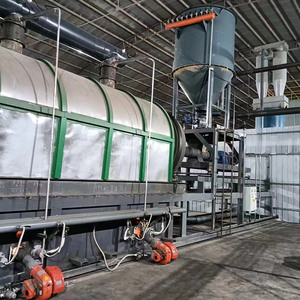
All categories
Featured selections
Trade Assurance
Buyer Central
Help Center
Get the app
Become a supplier

(8539 products available)





















The tire recycle machine pyrolysis processes used tires using high-temperature conditions in the absence of oxygen. Several designs exist to carry out this reaction, and they can be categorized by their heating method or their degree of integration.
By heating method
Indirect heating machines use another unit to generate heat that will then be transferred to the reactor. This is often done using thermal oil. The unit responsible for the heat generation will be outside of the reactor. For instance, the oil could be heated by a natural gas burner. When using indirect heating, the reactors can be smaller and easier to handle.
Direct heating pyrolysis machines have the heat source directly in contact with the reactor. Sometimes, the reactor will be rotated to evenly distribute the heat and ensure uniform processing of the feedstock. Directly heated reactors have a higher thermal efficiency.
By degree of integration
Integrated units combine shredding and pyrolysis into one machine. Usually, it is a continuous feeding system that includes a shredder before the pyrolysis chamber. The waste material is then fed into the reactor belt. These types of machines are more energy efficient.
Separating units are standalone shredders that process the material before it goes into the pyrolysis chamber. Many shredder units are now designed to integrate smoothly with the feed mechanism of existing pyrolysis reactors.
Capacity:
The capacity of a tire pyrolysis machine is typically expressed in tons per day (TPD) or batches per day. Common capacities range from 5-15 TPD, meaning the machine can process 5 to 15 tons of tires in a 24-hour period.
Feeding method:
Automatic feeding systems use mechanisms like conveyor belts or augers to continuously supply shredded tires into the reactor. Semi-automatic systems require operators to periodically batch and feed the tires into the reactor. Manual feeding is suitable for smaller capacity machines that cannot process large volumes at once.
Heating method:
The three common heating methods for tire recycling machines are electric heating, coal or wood firing, and natural gas or other combustible gas. Electric heating uses built-in electric heaters to raise the temperature of the reactor. Coal or wood firing requires burning solid fuels in an external furnace to heat the pyrolysis reactor. Natural gas heating uses a flame directly inside a burner situated below the pyrolysis reactor to provide indirect heating.
Oil output:
The type and amount of oil produced depend on factors such as the machine's configuration, operating conditions, and the composition of the recycled tires. Generally, tire pyrolysis machines can yield around 30% to 50% of the processed tires' weight as pyrolysis oil.
Condensing system:
The Condensing system in a tire recycling machine collects and cools down the vapor released during the pyrolysis process. This system is typically equipped with condensers and cooling units to effectively cool the vapor and convert it into liquid oil.
Gas treatment system:
The gas treatment system is responsible for handling the gaseous byproducts generated during pyrolysis. It typically includes filters, scrubbers, and other cleaning devices to remove harmful components and ensure the safe emission of gases.
Regular maintenance and timely repair of the waste tire recycling machine Can not only ensure product quality but also extend its service life. Here are some maintenance tips for waste tire recycling machines for buyers:
The pyrolysis of waste tires has a variety of application scenarios, indicating its importance in different industries.
In recent years, as more countries and regions have started to pay attention to environmental protection and sustainable development, the market demand for equipment for waste tire recycling through pyrolysis has increased significantly. Application scenarios in which waste tire recycling pyrolysis equipment is used include but are not limited to the following:
Choosing the right tire recycling machine involves more than just picking a model. It is about understanding the entire system and supply chain. Here are some key factors to keep in mind when selecting a tire recycling machine.
Q1: What is the principle of tire pyrolysis machine?
A1: The working principle of the tire pyrolysis machine involves thermal decomposition of tires without oxygen or in limited oxygen. Then, it produces a variety of products, including gases, oils, and char.
Q2: What are the advantages of pyrolysis of waste tires?
A2: There are many benefits to tire pyrolysis. The first benefit is that it recycles waste tires. Second, it produces valuable by-products. Finally, it reduces environmental pollution by reducing the volume of waste rubber materials.
Q3: What byproducts are produced from tire pyrolysis?
A3: The main by-products from tire pyrolysis machines are pyrolysis oil, carbon black, and steel wire (in the form of ferrous dust). The tire pyrolysis oil can be reprocessed to produce fuel or raw material for the chemical industry. The carbon black can be used as a pigment or reinforce in plastics and rubbers. The steel wire can be recycled to make new steel products.
Q4: What is the temperature of tire pyrolysis?
A4: Different manufacturers recommend various temperature ranges for pyrolysis of waste tires. The temperature range is often between 350°C to 650°C.
Q5: Is tire pyrolysis legal?
A5: The legality of tire pyrolysis varies from one country to another. Users must research the laws in their country and ensure compliance with local regulations. In some countries, the use of tire pyrolysis is legal, but users have to obtain permits and adhere to emission standards.